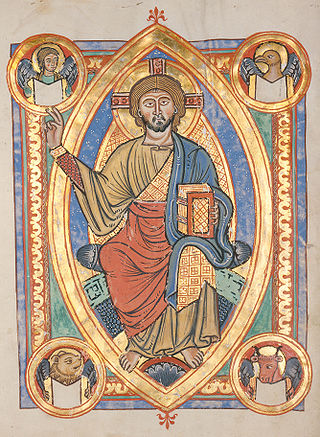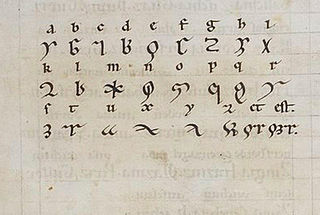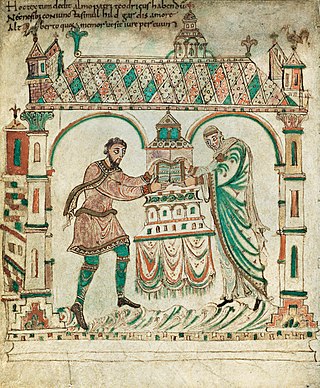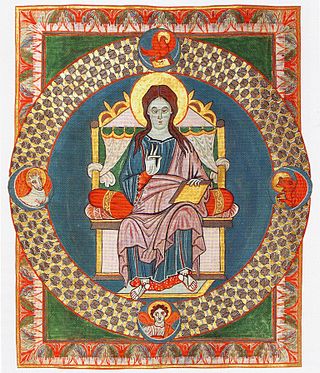
The Dendermonde Codex or sometimes called Villarenser Kodex or codex 9 of Dendermonde Abbey, [1] is a valuable manuscript containing the Symphonia harmoniae caelestium revelationum of Hildegard of Bingen. [2]

The Dendermonde Codex or sometimes called Villarenser Kodex or codex 9 of Dendermonde Abbey, [1] is a valuable manuscript containing the Symphonia harmoniae caelestium revelationum of Hildegard of Bingen. [2]
This valuable manuscript is owned by Dendermonde Abbey. [3] Historians believe it was first sent to the Belgian Villers Abbey, hence the name Villarensis. It then moved to Gembloux Abbey and finally it arrived in the famous Affligem Abbey, where the monks were chased out in 1796. In 1837, the Affligem community re-established conventual life in Dendermonde. When a colony of monks from Dendermonde returned to the original site of Affligem Abbey, the manuscript remained in Dendermonde. The Bingen manuscript is considered the most valuable of the library, and is world famous.
In August 2017, the abbey entrusted the manuscript to the library of the Faculty of Theology at the Catholic University of Leuven for conservation. [4]
The collection of songs inside the codex was named by Hildegard Symphonia Harmoniae Caelestium Revelationum. [5]
The current manuscript is not complete as several folios are missing. However, it still contains 183 folios, made of parchment, containing 60 psalmes and cantica in honour of Father and Son. [6] It is dated ca. 1176 A.D. and is considered one of the major works by Hildegard von Bingen.

Hildegard of Bingen, also known as Saint Hildegard and the Sibyl of the Rhine, was a German Benedictine abbess and polymath active as a writer, composer, philosopher, mystic, visionary, and as a medical writer and practitioner during the High Middle Ages. She is one of the best-known composers of sacred monophony, as well as the most recorded in modern history. She has been considered by scholars to be the founder of scientific natural history in Germany.
Plainsong or plainchant is a body of chants used in the liturgies of the Western Church. When referring to the term plainsong, it is those sacred pieces that are composed in Latin text. Plainsong was the exclusive form of Christian church music until the ninth century, and the introduction of polyphony.

Leuven or Louvain is the capital and largest city of the province of Flemish Brabant in the Flemish Region of Belgium. It is located about 25 kilometres east of Brussels. The municipality itself comprises the historic city and the former neighbouring municipalities of Heverlee, Kessel-Lo, a part of Korbeek-Lo, Wilsele and Wijgmaal. It is the eighth largest city in Belgium, with more than 100,244 inhabitants.

Dendermonde is a city in the Flemish province of East Flanders in Belgium. The municipality comprises the city of Dendermonde and the towns of Appels, Baasrode, Grembergen, Mespelare, Oudegem, Schoonaarde, and Sint-Gillis-bij-Dendermonde. Dendermonde is at the mouth of the river Dender, where it flows into the Scheldt. The town has a long-standing folkloric feud with Aalst, south along the same river, which dates from the Middle Ages.

A mandorla is an almond-shaped aureola, i.e. a frame that surrounds the totality of an iconographic figure. It is usually synonymous with vesica, a lens shape. Mandorlas often surround the figures of Jesus Christ and the Virgin Mary in traditional Christian iconography. It is distinguished from a halo in that it encircles the entire body and not just the head. It is commonly used to frame the figure of Christ in Majesty in early medieval and Romanesque art, as well as Byzantine art of the same periods. It is the shape generally used for mediaeval ecclesiastical seals, secular seals generally being round.

A lingua ignota was described by the 12th-century abbess Hildegard of Bingen, who apparently used it for mystical purposes. It consists of vocabulary with no known grammar; the only known text is individual words embedded in Latin. To write it, Hildegard used an alphabet of 23 letters denominated litterae ignotae.
Ordo Virtutum is an allegorical morality play, or sacred music drama, by Hildegard of Bingen, composed c. 1151, during the construction and relocation of her Abbey at Rupertsberg. It is the earliest morality play by more than a century, and the only medieval musical drama to survive with an attribution for both text and music.

Herrad of Landsberg was a 12th-century Alsatian nun and abbess of Hohenburg Abbey in the Vosges mountains. She was known as the author of the pictorial encyclopedia Hortus deliciarum.
The Codex Zographensis is an illuminated Old Church Slavonic canon manuscript. It is composed of 304 parchment folios; the first 288 are written in Glagolitic containing Gospels and organised as Tetraevangelium, and the rest written in Cyrillic containing a 13th-century synaxarium. It is dated back to the end of the 10th or beginning of the 11th century.

Scivias is an illustrated work by Hildegard von Bingen, completed in 1151 or 1152, describing 26 religious visions she experienced. It is the first of three works that she wrote describing her visions, the others being Liber vitae meritorum and De operatione Dei. The title comes from the Latin phrase Sci vias Domini. The book is illustrated by 35 miniature illustrations, more than that are included in her two later books of visions.
The eighth-century Codex Eyckensis is a Gospel Book based on two constituent manuscripts that were bound as a single codex from (presumably) the twelfth century until 1988. The Codex Eyckensis is the oldest book in Belgium. Since the eighth century it has been kept and preserved on the territory of the present-day municipality of Maaseik, in Belgium. The book was probably produced in the scriptorium in the Abbey of Echternach. It is housed in the church of St Catherine in Maaseik.

The Egmond Gospels is a 9th-century Gospel Book written in Latin and accompanied by illustrations. It is named after Egmond Abbey in what is now the Netherlands, to which it was given by Dirk II, and where it remained for six centuries. It is most famous for being the earliest surviving manuscript showing scenes with Dutch people and buildings, and represents one of the oldest surviving Christian art treasures from the Netherlands. The manuscript has been owned by the Royal Library of the Netherlands since 1830.

This is a discography of Hildegard of Bingen's musical works.
Columba Aspexit is a sequence written by Hildegard of Bingen in the late 12th century. It is one of seven sequences from her collection of lyrical poetry entitled Symphonia armonie celestium revelationum. This piece is found in only one manuscript: HS 2; Hessische Landesbibliotek, Wiesbaden, "Riesenkodex" (1175).
Alba are a Danish medieval music ensemble founded in 1992. The ensemble consists of the duo Agnethe Christensen and Poul Høxbro, or the trio with the harpist Helen Davis.
Canticles of Ecstasy is an album of sacred vocal music written in the 12th century by the German abbess Hildegard of Bingen and recorded by the early music ensemble Sequentia that was released by the Deutsche Harmonia Mundi recording label in 1993.

Barbara Stühlmeyer OblOSB is a German theologian, musicologist, author, especially a Hildegard scholar and a science journalism.

The Gero Codex or Gero-Codex is an Ottonian illuminated manuscript probably produced at Reichenau Abbey in Germany between 950 and 970. It is one of the first and most splendid of the Eburnant group of early Ottonian manuscripts.
Minuscule 1582, ε183, is a Greek minuscule manuscript of the four Gospels, written on parchment. It is dated by a colophon to 948. The manuscript was written by a monk named Ephraim, of which there are at least four other manuscripts known to have been written by him, including another New Testament manuscript, minuscule 1739. It is considered to be part of a group of manuscripts known as Family 1 (ƒ1) as a leading member, with a very similar text to minuscule 1.
Digital reproduction of the manuscript